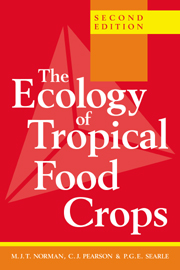12 - Soybean (Glycine max)
Published online by Cambridge University Press: 05 June 2012
Summary
Taxonomy
In the genus Glycine there are two subgenera: Glycine and Soja. The subgenus Glycine comprises six perennial Australasian species (2n = 40 or 80), none of which is used in agriculture. The subgenus Soja comprises two east Asian species: G. soja, the wild soybean, and G. max, the cultivated soybean (Singh & Hymowitz, 1987). Both are annuals (2n = 40). No hybrids between the subgenera Glycine and Soja have been reported, but there are virtually no cytogenetic barriers to hybridisation between G. soja and G. max.
Soybeans in the North American continent are classed in 12 maturity groups based on day length response. However, the US classification is of little value for discriminating between types within the general group of tropical soybeans. A classification for the tropics, shown in Fig. 12.1, has been proposed by Shanmugasundaram, Kuo & Nalampang (1980).
Origin, evolution and dispersal
G. soja is native to northern, northeastern and central China, adjacent regions of Kazakhstan, Korea, Japan and Taiwan. Evidence based on chromosome number and size, geographical distribution, and the electrophoretic banding pattern of seed proteins strongly suggests that G. max, which is not known in the wild state, is derived from G. soja. The linguistic, geographical and historical evidence indicates that G. max emerged as a domesticate in the eastern part of northern China about 3000 bp (Hymowitz, 1970). Changes during domestication include increased plant and seed size, modification from a twining to an erect habit, and reduced dehiscence of pods.
- Type
- Chapter
- Information
- The Ecology of Tropical Food Crops , pp. 225 - 239Publisher: Cambridge University PressPrint publication year: 1995



